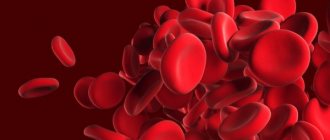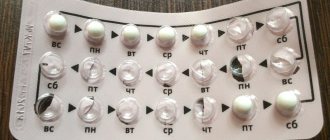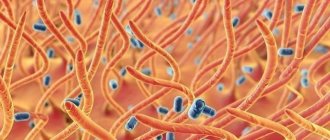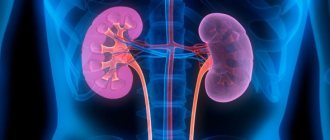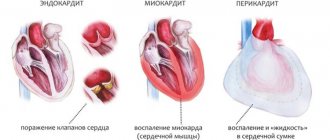What is interstitial nephritis?
Interstitial nephritis is a disease characterized by inflammation of the kidney tissue, which can lead to decreased kidney function and even complete kidney failure.
A simple way to understand interstitial nephritis is to think of it as an allergic reaction localized to the kidney (although this is an oversimplification).
Signs and symptoms of interstitial nephritis
Interstitial nephritis is generally divided into two categories based on the rate of onset and rate of decline in kidney function. These two categories:
- Acute interstitial nephritis (AIN ) , which is usually a sudden and usually rapid and persistent decline in kidney function.
- Chronic interstitial nephritis (CIN), which is a much more chronic, long-term disease.
Typically symptoms and signs, which tend to be more severe in acute interstitial nephritis, include:
- fever;
- skin rashes;
- pain in the sides;
- an increase in the number of a special type of leukocytes (so-called eosinophils) in the blood;
- an increase in blood creatinine, a marker whose levels are usually tested to evaluate kidney function;
- the presence of increased eosinophils in the urine;
- the presence of red blood cells in the urine (the number may be small enough to be assessed with the naked eye);
- increased protein leakage into urine. This condition is called "proteinuria" and is considered a nonspecific finding of kidney damage.
Although the above symptoms and signs are considered "classic symptoms", they are not always seen in all patients.
Various treatment options for the disease
In uncomplicated chronic tubulointerstitial nephritis, the patient receives most of the medications at home. To monitor the state of health and the dynamics of the process, it is necessary to regularly undergo tests and be examined by a specialist. In case of severe disease, the victim is hospitalized and measures are taken to stabilize his condition.
Main goals of therapy:
- normalization of blood pressure levels;
- stimulation of regeneration processes;
- increased activity of the immune system;
- prevention of the development of secondary complications;
- protecting the body from infections.
Table: pharmaceuticals for the treatment of chronic tubulointerstitial nephritis
| Name of the medication group | Examples of drugs | Main effects of the appointment |
| Nonsteroidal anti-inflammatory drugs |
| Relieves severe pain, lowers body temperature, eliminates swelling of soft tissues |
| Hormonal anti-inflammatory drugs |
| |
| Antihypertensive medications |
| Maintain stable blood pressure levels |
| Immunostimulants |
| Helps increase the overall activity of protective cells and protects against infections |
| Detoxification products |
| Removes toxins from the body in case of drug, drug or chemical poisoning |
Photo gallery: medications for the treatment of chronic tubulointerstitial nephritis
Capoten normalizes blood pressure
Immunal strengthens the immune system
Ketorol relieves pain and inflammation
Dietary recommendations for patients
With such a pathology, the load on the kidneys, which cleanse the blood of foreign impurities and eliminate them, sharply increases. Many chemicals enter the body in varying quantities with food: this is why it is so important to monitor the quality of food. Doctors advise eating small portions 5-6 times a day, limiting the amount of table salt, eliminating fast food, alcoholic drinks, fatty and fried foods. The diet should consist mainly of natural products that are heat-treated.
Sample nutrition menu for patients with a similar diagnosis:
- Breakfast. Omelette of two eggs with low-fat milk with the addition of parsley, cilantro, basil and spinach. Some toast with butter and goat cheese. As a drink, you can use natural freshly squeezed juice or tea.
- Dinner. Borscht made with lean beef and dill. Vegetable salad of cucumbers, cabbage, tomatoes and onions.
- Dinner. Durum pasta with broccoli, green peas and fish medallions (salmon, pollock). You can also eat a few crispbreads.
- Snacks. Vegetables, berries, nuts or dried fruits in combination with cottage cheese or yogurt.
Photo gallery: healthy food
Vegetables and fruits are rich in vitamins
Nuts are the best source of amino acids
Dairy products contain a lot of calcium
Folk remedies for relieving symptoms of chronic tubulointerstitial nephritis
Some kidney problems can be treated with alternative medicine. Folk remedies based on medicinal plants and herbs also have healing properties. But do not forget that you can completely get rid of the disease and the cause that caused it only with pharmaceutical drugs. All natural recipes help to cope only with symptoms.
One of my patients, who was diagnosed with chronic tubulointerstitial nephritis, upon learning of her diagnosis, refused hospitalization and subsequent treatment. She went home and sought the services of a healer, who prescribed her to take unnatural dietary supplements and tinctures. As a result of the treatment received, the woman’s condition rapidly deteriorated, and one day the victim fell into a coma. The patient was urgently taken to our hospital, where doctors performed the necessary interventions. It turned out that due to improper therapy, she developed uremic intoxication of the body, which entailed undesirable consequences.
The most popular drugs for the treatment of chronic tubulointerstitial nephritis:
- Mix 50 grams of fresh or frozen raspberries with the same amount of blueberries and pour a liter of boiling water. After cooling, drink 1 glass of the product in the morning and evening. These berries have a pronounced anti-inflammatory effect, relieve swelling of soft tissues and relieve discomfort. This product must be used at least twice a week for a month.
- Brew one teaspoon of calendula in a glass of boiling water and leave overnight. In the morning before breakfast, drink the product and start eating after 15 minutes. Calendula is believed to have antiseptic and antimicrobial properties, protecting the body from harmful microbes. This remedy should be used 2-3 times a week for six months.
- Mix 100 grams of lingonberries with 50 grams of blackberries and add 2 slices of lemon, placing everything in a saucepan with 2 liters of water. Cook for half an hour, stirring constantly. Then you can add sugar or honey according to your taste preferences. You need to drink 1 glass of this remedy every 3 hours: this will remove toxic substances from the body. The cleansing procedure should be carried out no more than once a week.
Photo gallery: folk remedies to combat pathology
Raspberries also reduce fever
Calendula has an anti-inflammatory effect
Lingonberry helps eliminate toxins
Possible complications
Metabolic acidosis may occur as a result of the disease because the kidneys cannot remove enough acid. The disorder can lead to acute or chronic kidney failure or end-stage chronic kidney disease.
How does it manifest?
The most common symptoms of the disease are:
- The appearance of fever (from moderately low temperature to more than 39°C),
- Dull pain in the lumbar region.
- Skin rash in various places.
Joint pain may also occur. Urine may be red in color (hematuria) and its volume may decrease, which is a symptom indicating the development of acute renal failure.
Permanent tubulointerstitial nephritis may be asymptomatic for many years.
Causes and risk factors of interstitial nephritis
As described above, interstitial nephritis is almost the same as an inflammatory or allergic reaction in the kidney and is usually caused by certain inflammatory factors. The provoking agent behaves like an “allergen” that causes an allergic reaction. Drugs are a common cause, but other triggers are possible. Here's a quick overview of some common disease triggers:
- Medicines: These include antibiotics such as penicillins, quinolones (such as ciprofloxacin), common over-the-counter pain medications such as nonsteroidal anti-inflammatory drugs (NSAIDs), acid reflux medications (called proton pump inhibitors), diuretics/diuretics, etc. d. Why someone reacts to a particular drug while others feel fine is not entirely understood, but it has to do with how a person's immune system responds to a particular trigger. This can be understood in the same way as, for example, not everyone is necessarily allergic to peanuts.
- Infectious diseases: Infections are known to cause interstitial nephritis. In theory, any infectious agent could be a stimulating factor, but examples include bacteria such as streptococci, viruses such as Epstein-Barr virus, Leptospira, and various parasites.
- Autoimmune diseases: Another group of common diseases associated with acute interstitial nephritis. These include well-known autoimmune diseases such as Liebman-Sachs disease or systemic lupus erythematosus (SLE), Sjögren's syndrome, autoimmune thyroiditis (Hashimoto's disease), rheumatoid arthritis, etc.
- TINU syndrome (tubulointerstitial nephritis with uveitis) is a specific condition whose pathogenesis is unknown. Potential suspects include medications, infectious agents such as chlamydia, and a certain Chinese herb called goreisan. Patients report pain in the side, blood or protein in the urine, and worsening kidney function. Uveitis, which is an inflammation of certain tissues in the eye, will appear as eye pain or redness.
Forecast
If acute tubulointerstitial inflammation was caused by taking medications, then kidney function can be restored 1.5-2 months after discontinuation of the provoking medication. But sometimes residual scarring may be detected. Restoration of kidney function may be incomplete, and azotemia will be higher than reference values.
The prognosis is often worse if the pathology is provoked by non-steroidal anti-inflammatory drugs.
In the case of other causes of acute pathology, changes at the histological level are often reversible if the provocateur was identified and eliminated as early as possible. But in severe clinical situations, the development of a pathological process up to fibrosis and chronic kidney disease is possible.
Regardless of the provocateurs, the likelihood of irreversible changes is high if:
- diffusely widespread rather than local infiltration of the interstitium;
- significant interstitial fibrosis;
- delayed response to prednisolone;
- acute damage to kidney tissue that lasts more than three weeks.
The prognosis in the case of a chronic form of the disease is determined by its causes, the possibility of their early detection and elimination before fibrotic changes.
Hereditary, metabolic and toxic provocateurs, in many cases, cannot be eliminated. In such situations, chronic inflammation of the tubular apparatus and interstitium leads to end-stage chronic renal disease.
There are more provocateurs of the chronic form of tubulointerstitial nephritis, and they differ in pronounced diversity compared to the provocateurs of the acute form of the disease. Clinical symptoms often either do not appear or are not specific.
Diagnosis of interstitial nephritis
A doctor can make a diagnosis of possible interstitial nephritis based only on clinical symptoms and signs. However, as noted above, not all symptoms or signs are necessarily observed in all patients. In the case of drug-induced interstitial nephritis, the patient usually comes with a history of recent drug use, and a before-and-after comparison of kidney blood test results can be a potential diagnostic clue.
In cases where the diagnosis is not easy to make or when kidney function is severely reduced, a kidney biopsy may be required. This is an invasive test that involves taking a tiny piece of kidney tissue and examining it under a microscope.
Prevention
Manifestations of interstitial nephritis can be prevented by following these recommendations:
- do not self-medicate, take medications only as prescribed and under the supervision of a doctor;
- adhere to a balanced diet;
- avoid hypothermia;
- drink plenty of fluids, especially clean water;
- to refuse from bad habits;
- treat infectious diseases in a timely manner.
It is also important to adhere to preventive measures to prevent infection with viral and fungal diseases.
The kidneys help eliminate toxic substances; the normal functioning of the entire body depends on their work. If not treated promptly, interstitial nephritis can cause serious health problems.
Author: Oksana Belokur, doctor, especially for Nefrologiya.pro
Treatment of interstitial nephritis
Once a definitive diagnosis of interstitial nephritis has been made, every effort should be made to identify the precipitating factor in order to eliminate the cause of the inflammation, if possible. For example, in the case of drug-induced interstitial nephritis, it is important to stop using those drugs, which is the most common first step. If no medications have been taken, a search for other autoimmune and infectious agents should be performed.
In patients with mildly impaired renal function, it is usually only necessary to stop the offending agent. However, if there is significant inflammatory decline in kidney function, treatment with steroids may be helpful (in this case, therapy for 2-3 months may be necessary). In patients who do not respond to steroids, another drug called mycophenolate may be considered as an alternative measure.
Diet
If the patient has no symptoms of the chronic course of the disease, then he is prescribed a physiologically complete diet. The diet will be structured so that the human body receives all the substances it needs - fats, vitamins, proteins, carbohydrates. It is important to limit your consumption of table salt. This is especially true if the patient has high blood pressure.
Diet for chronic disease has other nuances. Its action is aimed at correcting oxalate-calcium metabolism. Doctors, as a rule, prescribe a cabbage-potato diet to patients.
Be sure to exclude from the diet foods that can negatively affect the tubular apparatus of the kidneys - citrus fruits, spicy, fatty and smoked foods. Spices are also excluded.
The diet will help restore normal kidney function. But it is also important to drink at least two liters of fluid per day. It's better if it's just purified water.
